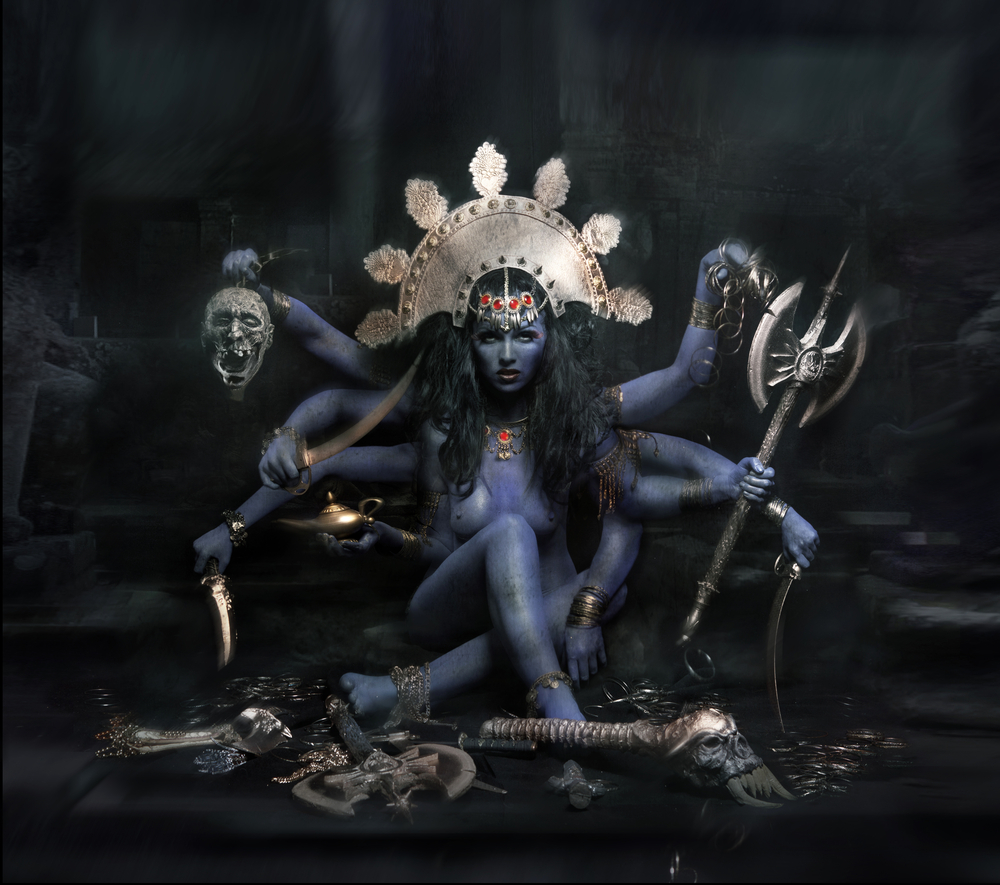
Hinduism is the world’s third-largest religion and has been practiced for thousands of years. Interestingly, unlike a number of modern religions, there are no specific religious books, authorities, or governing bodies dictating the belief system. This has led to the development of countless practices that fall under the umbrella of Hinduism. One common belief to many followers is the belief in a consistent array of deities. While not all practicing Hindus are polytheistic, most recognize the various gods and goddesses in some capacity. One goddess that tends to invoke confusion for outsiders is Kali.
As the embodiment of both total destruction and nurturing motherhood, it is easy to see how the duality creates confusion. Let’s learn more about Kali.
Depiction of Kali
Kali is often depicted as a woman with blue skin, a lolling tongue, and anywhere from four to eighteen arms. In art and literature, she is often wearing a necklace made of human heads and a skirt of arms. One of her hands usually brandishes a bloody blade of some type, and she is often shown either seated or in wild configurations. Her name loosely translates from Sanskrit to mean “she who is death.” The goddess is usually viewed as the all-consuming darkness of death and the end of all life via a universal apocalypse.
Due to her association with death, Kali was said to frequent battlefields and places of decay. Kali is not exclusively perceived as a figure of death in a negative context, however. Despite her sometimes fearsome appearance, Kali’s all-consuming nature is meant to symbolize the potential for the destruction of what was and creation of what will be. She is often referred to as the Mother of the Universe, and the one who will inevitably bring about its ultimate destruction. In more recent centuries, she has also been associated with other more typical characteristics of mother goddesses, such as fertility.
Demon Slayer
Kali has appeared in a number of texts and myths surrounding Hinduism. One of her more famous stories involves the slaying of the demon Raktabija. The legend states that the goddess Durga wounded Raktabija only to discover the demon’s blood created copies of the demon. Soon, there were hundreds of copies of Raktabija aiming to cause endless destruction. Durga summoned Kali to the battlefield. She immediately consumed the original Raktabija and all of the demon’s copies. Some stories state that Durga is also Kali’s mother, but there are multiple conflicting myths surrounding Kali’s birth.
Primordial Darkness
Kali is often said to represent the darkness that existed before the creation of the universe. In this form, Kali is a goddess of creation, allowing all life to be birthed from her canvas. This has led many followers over the years to associate Kali with nature. To this day, individuals who worship the goddess will look at her as one who protects and preserves nature. Her connection with the primordial darkness and nature itself is what led Kali to be viewed as more of a mother goddess in the eyes of Hindus over recent generations.
Kali Outside of Hinduism
Because Kali has existed in one form or another for hundreds of years, it is understandable that the figure had an impact on other cultures. Many believe that Saint Sarah, a prominent figure to the Romani people of Europe, traces her origins back to when Kali was introduced to the nomads at some point in their history. There are also many pagan groups throughout Europe and America who consider Kali a goddess worth paying tribute to.
This information barely scratches the surface when it comes to the complexities of Kali and what she represents to various groups of Hindus around the world. I encourage you to find more resources online to see just how she figures within our global concept of mythology.

